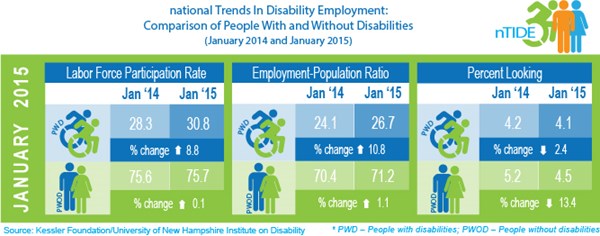WEST ORANGE, N.J., Feb. 6, 2015 (GLOBE NEWSWIRE) -- As 2015 begins, Americans with disabilities continue to make employment gains for the fourth consecutive month, according to today's National Trends in Disability Employment – Monthly Update (nTIDE), issued by Kessler Foundation and University of New Hampshire's Institute on Disability (UNH-IOD).
In the Bureau of Labor Statistics' Jobs Report released Friday, February 6, the labor force participation rate increased substantially from 28.3 percent in January 2014 to 30.8 percent in January 2015 (up 8.8 percent; 2.5 percentage points) for working-age people with disabilities. For people without disabilities, the labor force participation rate increased only slightly from 75.6 percent in January 2014 to 75.7 percent in January 2015 (up 0.1 percent; 0.1 percentage points). The labor force participation rate is the percentage of the population that is working or actively looking for work.
"More Americans with disabilities are participating in paid work," according to John O'Neill, Ph.D., director of employment and disability research at Kessler Foundation. "An increase in employment for people with disabilities for the fourth month in a row is quite a turnaround from what we have been seeing since we started releasing the nTIDE report in March 2013."
The employment-to-population ratio also increased from 24.1 percent in January 2014 to 26.7 percent in January 2015 (up 10.8 percent; 2.6 percentage points) for working-age people with disabilities. In contrast, the employment-to-population ratio increased slightly from 70.4 percent in January 2014 to 71.2 percent in January 2015 (up 1.1 percent; 0.8 percentage points) for people without disabilities. The employment-to-population ratio, a key indicator, reflects the percentage of people who are working relative to the total population (the number of people working divided by the number of people in the total population multiplied by 100). In comparison to January 2014, 460,000 more Americans with disabilities are in the workforce.
"Each month that we see positive news strengthens the evidence that we are seeing a reversal in the downward employment trend that the population with disabilities has experienced since the Great Recession. It will take quite a bit more time to determine whether there is a real change in the downward trend that we have seen for decades," said Andrew J. Houtenville, Ph.D., associate professor of economics and research director at UNH-IOD.
Private funders are supporting efforts that expand employment opportunities for people with disabilities. To close 2014, Kessler Foundation awarded $2.1 million in grants to organizations across the U.S. to fund several such projects. ServiceSource of Florida's "Warrior Bridge Brain Injury Demonstration Project," for example, will increase the integration, independence and employment outcomes for individuals with brain injury, including veterans, through a clubhouse model. Foundation funding also supports "21 and Able" at United Way of Allegheny County in Pennsylvania, to place embedded professionals in corporations to aid the hiring of young adults in the transition from school to the workplace.
"It is critical to support initiatives that can be scaled and replicated to help large numbers of job-seekers with disabilities find satisfying careers," said Elaine E. Katz, senior vice president of Grants and Communications. "Through concerted efforts by funders, businesses, legislators and supporters in the disability field, more individuals with disabilities can earn a paycheck and make contributions that enrich the workplace and strengthen our economy."
In January 2015, among workers ages 16-64, the 4,124,000 workers with disabilities represented 3 percent of the total 138,317 workers in the U.S.
"The statistics in nTIDE are not seasonally adjusted," noted Dr. O'Neill. "Because disability employment data have been collected for so few years, more time is needed for seasonal trends to become evident."
The next nTIDE will be issued on Friday, March 6, 2015.
NOTE: The statistics in the National Trends in Disability Employment – Update are based on Bureau of Labor Statistics numbers, but are NOT identical. They have been customized by the University of New Hampshire to efficiently combine the statistics for men and women of working age (16 to 64).
nTIDE is funded, in part, by grants from the National Institute on Disability and Rehabilitation Research (H133B130015 & H133B120005) and Kessler Foundation.
About Kessler Foundation
Kessler Foundation, a major nonprofit organization in the field of disability, is a global leader in rehabilitation research that seeks to improve cognition, mobility and long-term outcomes, including employment, for people with neurological disabilities caused by diseases and injuries of the brain and spinal cord. Kessler Foundation leads the nation in funding innovative programs that expand opportunities for employment for people with disabilities. For more information, visit KesslerFoundation.org.
About the Institute on Disability at the University of New Hampshire
The Institute on Disability (IOD) at the University of New Hampshire (UNH) was established in 1987 to provide a coherent university-based focus for the improvement of knowledge, policies, and practices related to the lives of persons with disabilities and their families. For information on the NIDRR-funded Employment Policy and Measurement Rehabilitation Research and Training Center, visit http://www.ResearchonDisability.org.
For more information, or to interview an expert, contact:
Lauren Scrivo, 973.768.6583, LScrivo@KesslerFoundation.org
Carolann Murphy, 973.324.8382, CMurphy@KesslerFoundation.org
A photo accompanying this release is available at: http://www.globenewswire.com/newsroom/prs/?pkgid=30566
